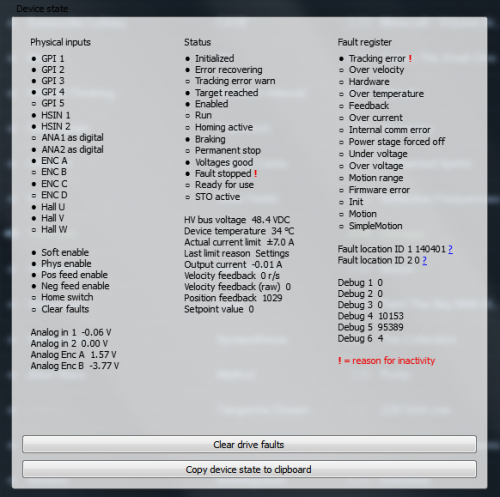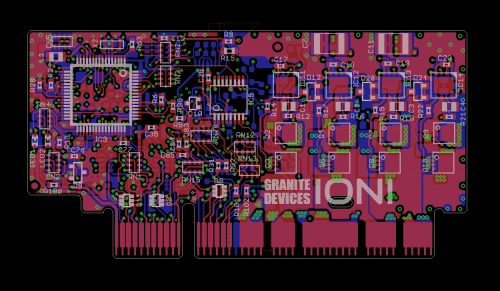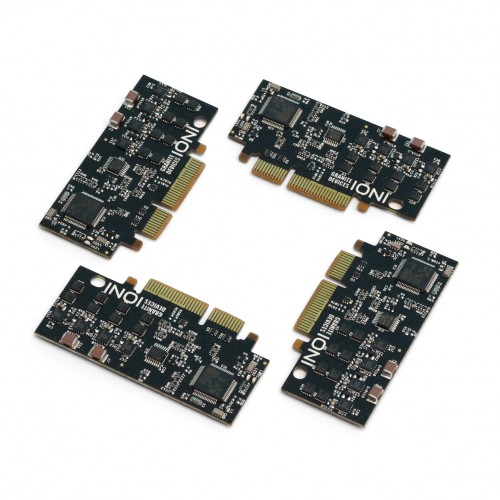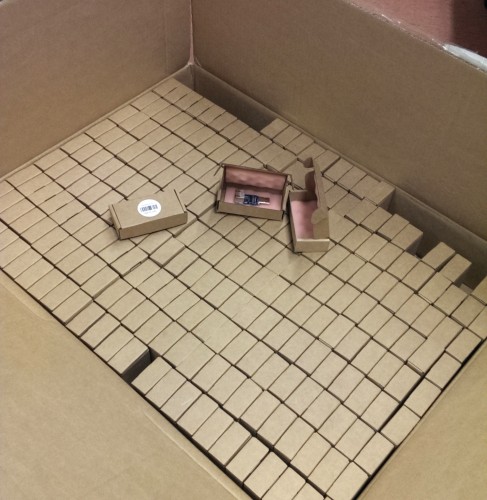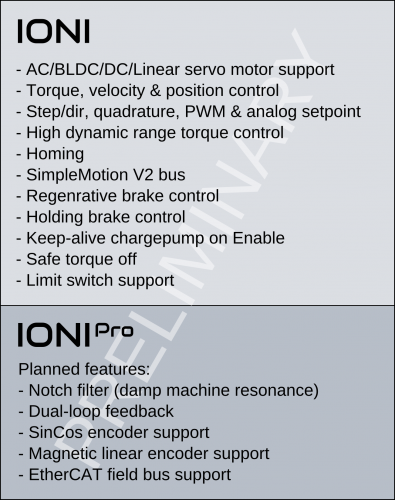While we develop IONI, we are also developing Granity setup software. Yesterday’s little innovation was to add visual aids for displaying the reason why drive is not in active state.
Category Archives: Ioni
IONI in production!
The first production batch of IONI went into production! We should see final devices arrive in February. While we wait, we will be finishing firmware, documentation and Granity to the point where we can start shipping drives immediately after arrived & tested.
8x it is – and effective output voltage boosted too
Thanks for votes & opinions! I agree that we should go for 8x connector and now it’s done.
In the other news, drive PWM modulation depth was adjusted to match hardware capabilities. It’s bumped from 88% (same as VSD-E and Argon) to a new record level of 97%. Modulation depth means the maximum duty cycle swing that power stage can produce. This means another 10% increase to effective output voltage vs drive supply voltage. With the “PWM magic trick” the total change now is +27.8%. So the 55 V supply now equivalent to 70 V in the original firmware scale.
I wish happy new year 2015 to all our fellow followers!
Mach4 support on the works
We have started development of Mach4 motion control plugin that supports SimpleMotion V2 bus. This means that ARGON and IONI drives can be controlled by Mach4 without any extra hardware. It just needs the SMV2 USB adapter and drives. The plan is also to allow control of few I/O signals through that plugin.
The plugin will be fully open source and available on GitHub if Artsoft sample plugin code license allows that (will be determined later).
Granite Devices will be on Christmas holiday for the next week. I wish merry Christmas to everyone following this blog! :)
3-phase magic trick
Latest innovation made to IONI firmware allows generating 15% higher output voltage for 3 phase AC motors which in practice means 15% greater maximum possible speed of motor. This is achieved by by altering the duty cycle generation of power stage so that it’s being utilized better for this kind of waveforms.
By looking the typical 3-phase motor voltage waveforms below, one can notice the peaks of sine waves occur one-at-a-time which means there is some headroom in the opposing polarity waves.
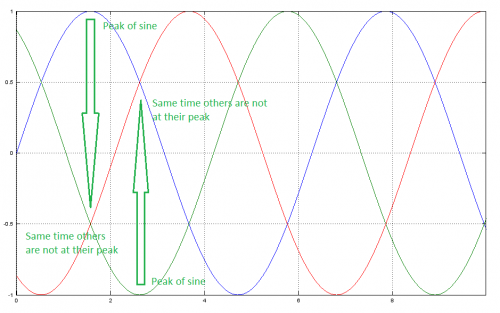
Standard 3 phase sinusoidal waveforms. Range from 1 to -1 means it uses full output voltage span available in drive (i.e. 0V to 55V)
We can utilize these empty gaps by shifting all three waves up and down so that empty gaps become filled.
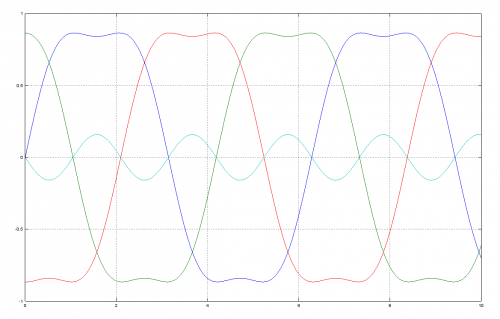
Same signals with summed third harmonic (cyan) to all phase values. This reduces peak amplitude of all signals by 15% without affecting to any phase-to-phase waveform shape or amplitude. In other words, motor sees no difference between this and the original.
After this step, we can multiply them by 1.15 without exceeding the maximum range of +/-1. This method has been tested and it works flawlessly. Same smoothness but just a bit higher speed range is available from the drive. The trick effectively does same as increasing drive supply voltage from 55 V to 64 V without actually increasing it.
This, and as many as possible, new features of IONI will be ported back to ARGON as soon as the IONI is out.
Adaptive current limit
We have been experimenting with adaptive current limit on IONI prototypes. This means there isn’t fixed specifications saying how much current drive outputs continuously and peak but there is just one specification: maximum. Drive will allow maximum output if it runs cool enough and will start throttling down current if temperature rises beyond certain level. This means, if you cool it well, you will get lots of power.
So far it seems to be working very nicely! See the video below.
As we were now able to push prototypes to their limits without worrying to break the only units, it turned out that we have been underestimating them! Without cooling it seems to output approx 9-10 Amps and with cooling 15 Amps (actually it could go higher but the lab power supply ran out of juice). What do you think about this?
IONIs are here!
No words needed, but I write anyways! Today is the day when first production candidate IONI drives arrived. Few minutes after arrival, the first motor was spinning with great success.
So far everything is looking very good. Someone please come and tie me to the chair so I can stop floating around!
It’s now called IONICUBE and it’s here!
As title says, the former IONISPHERE motherboard for IONI drives is now renamed as IONICUBE which describes the shape better :) Thanks you João for sharing the idea in comments, you will get one set for free once ready!
Changes from the prototype are mainly
- Fine-tune PCB layout
- Larger power connector
- 1.5 Amp vs 0.5 Amp voltage regulator for power hungry encoders
- Connector for external braking resistor if on-board resistor should become insufficient
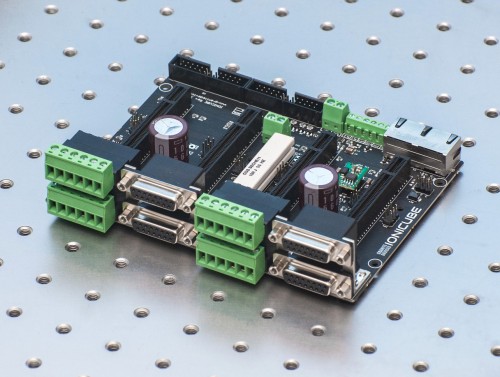
Factory made IONICUBE on a nice steel table with some honey comb vibration dampening structure inside
Now we’re just waiting IONI prototypes to arrive (expecting on the next week). Feels like Christmas is early this year :)
Boxes for the first 500
IONI plans
As we are expecting the release candidate prototypes of IONI arrive any moment now on the first week of December according to factory, it’s good to shed light to the plans regarding the drive.
Here is a draft of one option: we launch a standard model which has all the features we have implemented to the date (pretty much all the stuff that Argon has) and a Pro version where we add sophisticated features that may be useful for the most demanding applications.
One might wonder why not to put everything into the one model. The reasons for separating the models into different price versions traces back to the cost. There will be cost of development and support that affect the Pro version price. Support is the main factor here. More sophisticated features inevitably generate more support overhead and that costs our time. If a customer buys lots of drives, then price of the two will become nearly same as the difference in support becomes near equal.
And the good news for early birds: as the implementation of Pro features will begin after standard IONI model launch, and there is no much extra in Pro, the early bird users will be receiving the Pro version at the price of standard model :-)

